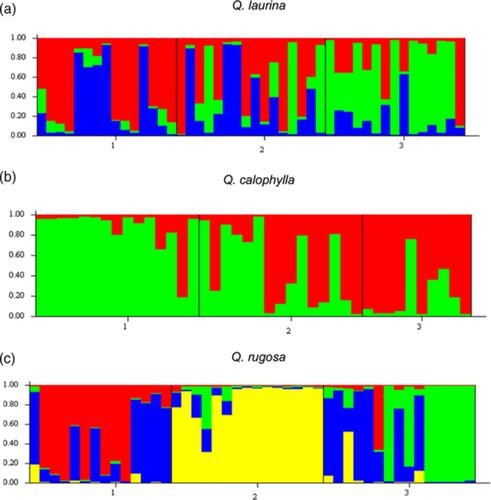当前位置:
X-MOL 学术
›
Ann. Appl. Biol.
›
论文详情
Our official English website, www.x-mol.net, welcomes your
feedback! (Note: you will need to create a separate account there.)
Genetic diversity in oak populations under intensive management for fuelwood in the Sierra de Zongolica, Mexico
Annals of Applied Biology ( IF 2.2 ) Pub Date : 2020-08-31 , DOI: 10.1111/aab.12639 Miguel Ángel Vega‐Ortega 1 , Jesús Llanderal‐Mendoza 2 , Patricia Gerez‐Fernández 1 , Citlalli López‐Binnquist 3
Annals of Applied Biology ( IF 2.2 ) Pub Date : 2020-08-31 , DOI: 10.1111/aab.12639 Miguel Ángel Vega‐Ortega 1 , Jesús Llanderal‐Mendoza 2 , Patricia Gerez‐Fernández 1 , Citlalli López‐Binnquist 3
Affiliation

|
Firewood and charcoal are used on a daily basis both in rural areas and in cities. This type of energy is produced by one of the most ancient traditional methods, known as coppice, which harvest tree sprouts. There is controversy about its effects on forests: it preserves populations and tree cover of species used, but reduces density, inhibits sexual reproduction and generates genetic erosion. We inquired if it was possible to identify a loss of genetic diversity in oak populations traditionally used for charcoal by the Zongolica Nahuas in Veracruz state, Mexico. We studied populations of Quercus laurina, Quercus calophylla and Quercus rugosa in three different altitudes. Molecular analysis with eight nuclear codominant microsatellites was performed to determine the diversity, structure and gene flow of these species. Results for Q. laurina were Na = 8.458, I = 1.766, Ho = 0.679, polymorphism = 100%, Fis = 0.079, with intraindividual variation of 81.55%. For Q. calophylla: Na = 7.250, I = 1.563, Ho = 0.646, polymorphism = 91.67%, Fis = 0.083, with intraindividual variation of 83.80%. For Q. rugosa: Na = 6.958, I = 1.510, Ho = 0.574, polymorphism = 91.67%, Fis = 0.204, with intraindividual variation of 81.99%; this species shows signals of an early genetic isolation process. Our findings indicate that Quercus genetic diversity for the three species is high and comparable with oak species in Mexico and worldwide. We conclude that at the present, coppice is preserving a historical diversity in adult trees kept alive through sprouting. Nonetheless, problems with coppice systems elsewhere, unregulated harvesting and expansion of pine plantation in the region suggest that further studies, hand in hand with a landscape management approach that improve charcoal and firewood production, may be valuable for Sierra de Zongolica genetic biodiversity conservation.
中文翻译:

在墨西哥塞拉利昂宗格里卡大区对薪柴进行密集管理的橡树种群遗传多样性
在农村地区和城市,每天都使用木柴和木炭。这种能量是通过最古老的传统方法(称为“小灌木丛”)产生的,该方法可收获树苗。关于其对森林的影响存在争议:它可以保护所用物种的种群和树木,但会降低密度,抑制有性繁殖并产生遗传侵蚀。我们询问是否有可能在墨西哥韦拉克鲁斯州的Zongolica Nahuas传统上用作木炭的橡树种群中发现遗传多样性的丧失。我们研究了月桂栎,栎栎和皱皮栎的种群在三个不同的高度。用八个核共性微卫星进行了分子分析,以确定这些物种的多样性,结构和基因流。月桂Q.的结果为Na = 8.458,I = 1.766,Ho = 0.679,多态性= 100%,Fis = 0.079,个体差异为81.55%。对于Q. calophylla:Na = 7.250,I = 1.563,Ho = 0.646,多态性= 91.67%,Fis = 0.083,个体差异为83.80%。为Q.藿香:NA = 6.958,我= 1.510,何= 0.574,多态性= 91.67%,Fis的= 0.204,具有81.99%个体内变动; 该物种显示出早期遗传分离过程的信号。我们的发现表明这三个物种的栎属遗传多样性很高,可与墨西哥和全世界的橡树种相媲美。我们得出的结论是,目前,小灌木林正在保存通过发芽而存活的成年树木的历史多样性。但是,该地区其他地方的小灌木林系统存在问题,该地区松树种植的收割和种植不受管制,这表明进一步研究与改善木炭和薪柴产量的景观管理方法相结合,可能对Zongolica遗传多样性保护具有重要意义。
更新日期:2020-08-31
中文翻译:

在墨西哥塞拉利昂宗格里卡大区对薪柴进行密集管理的橡树种群遗传多样性
在农村地区和城市,每天都使用木柴和木炭。这种能量是通过最古老的传统方法(称为“小灌木丛”)产生的,该方法可收获树苗。关于其对森林的影响存在争议:它可以保护所用物种的种群和树木,但会降低密度,抑制有性繁殖并产生遗传侵蚀。我们询问是否有可能在墨西哥韦拉克鲁斯州的Zongolica Nahuas传统上用作木炭的橡树种群中发现遗传多样性的丧失。我们研究了月桂栎,栎栎和皱皮栎的种群在三个不同的高度。用八个核共性微卫星进行了分子分析,以确定这些物种的多样性,结构和基因流。月桂Q.的结果为Na = 8.458,I = 1.766,Ho = 0.679,多态性= 100%,Fis = 0.079,个体差异为81.55%。对于Q. calophylla:Na = 7.250,I = 1.563,Ho = 0.646,多态性= 91.67%,Fis = 0.083,个体差异为83.80%。为Q.藿香:NA = 6.958,我= 1.510,何= 0.574,多态性= 91.67%,Fis的= 0.204,具有81.99%个体内变动; 该物种显示出早期遗传分离过程的信号。我们的发现表明这三个物种的栎属遗传多样性很高,可与墨西哥和全世界的橡树种相媲美。我们得出的结论是,目前,小灌木林正在保存通过发芽而存活的成年树木的历史多样性。但是,该地区其他地方的小灌木林系统存在问题,该地区松树种植的收割和种植不受管制,这表明进一步研究与改善木炭和薪柴产量的景观管理方法相结合,可能对Zongolica遗传多样性保护具有重要意义。











































 京公网安备 11010802027423号
京公网安备 11010802027423号